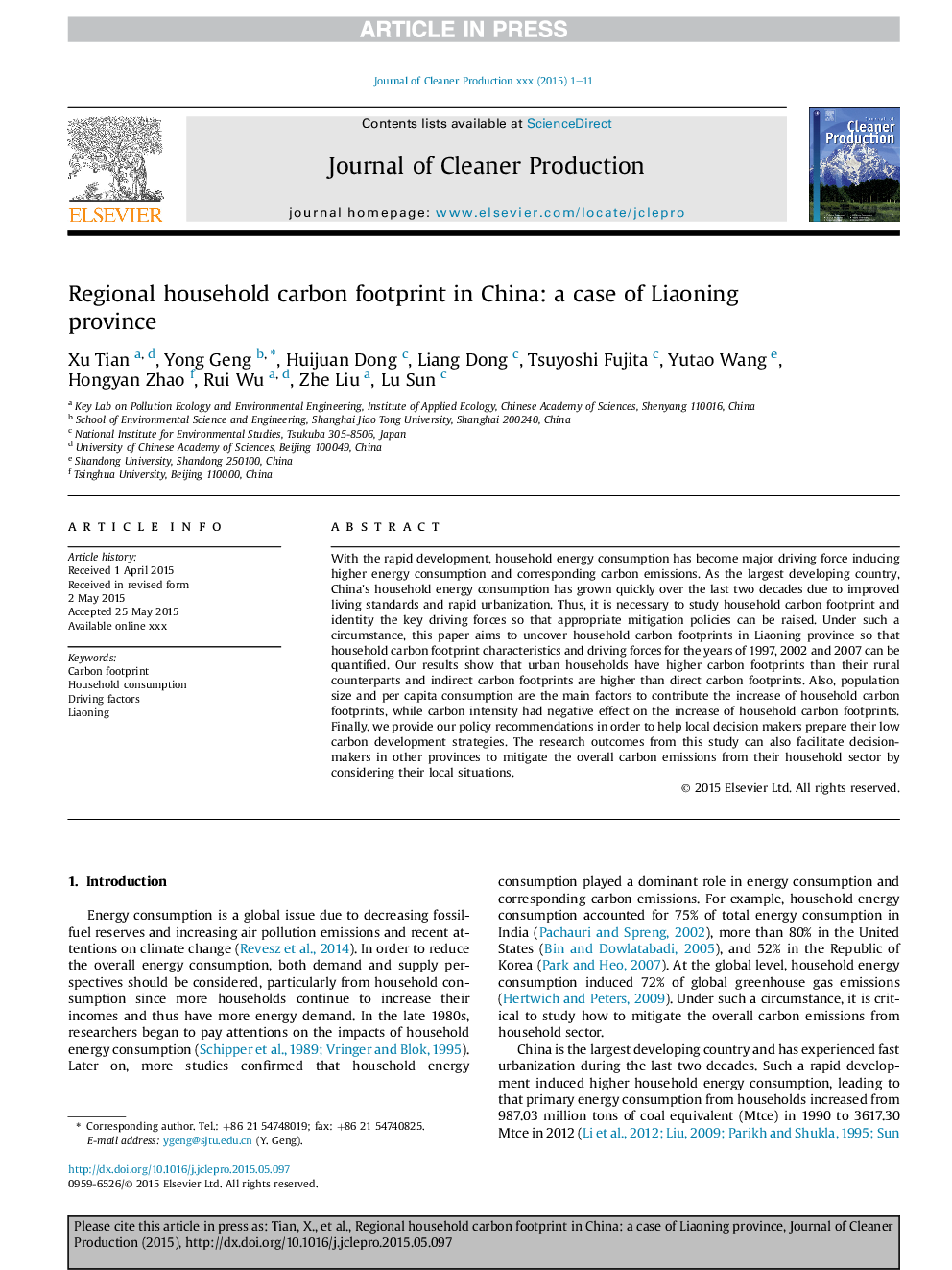| کد مقاله | کد نشریه | سال انتشار | مقاله انگلیسی | نسخه تمام متن |
|---|---|---|---|---|
| 8102784 | 1522135 | 2016 | 11 صفحه PDF | دانلود رایگان |
عنوان انگلیسی مقاله ISI
Regional household carbon footprint in China: a case of Liaoning province
ترجمه فارسی عنوان
پس زمینه کربن منطقه ای خانگی در چین: یک مورد استان لیائونینگ
دانلود مقاله + سفارش ترجمه
دانلود مقاله ISI انگلیسی
رایگان برای ایرانیان
کلمات کلیدی
رد پای کربن، مصرف خانگی، عوامل رانندگی، لیائونینگ،
ترجمه چکیده
با رشد سریع، مصرف انرژی خانوار به عنوان یک موتور محرک اصلی باعث افزایش مصرف انرژی و انتشار گازهای گلخانه ای شده است. با توجه به بهبود شرایط زندگی و شهرنشینی سریع، به عنوان بزرگترین کشور در حال توسعه، مصرف انرژی خانوار در چین طی دو دهه گذشته به سرعت افزایش یافته است. بنابراین ضروری است که ردپای کربن خانه و هویت را به عنوان عوامل کلیدی رانندگی مورد بررسی قرار دهیم تا سیاست های کاهش مناسب را افزایش دهد. تحت چنین شرایطی، این مقاله با هدف کشف ردپای کربن خانگی در استان لیائونینگ به طوری که ویژگی های ردیابی کربن خانه و نیروهای رانندگی برای سال های 1997، 2002 و 2007 می تواند کمیت باشد. نتایج ما نشان می دهد که خانواده های شهری دارای رد پای کربن بالاتر نسبت به همتایان روستایی خود و رد پای کربن غیر مستقیم بالاتر از رد پای کربن هستند. همچنین اندازه جمعیت و مصرف سرانه عوامل اصلی برای افزایش ردپای کربن خانگی است، در حالیکه شدت کربن تاثیر منفی بر افزایش ضایعات کربن خانگی داشته است. در نهایت، توصیه های سیاستی ما را برای کمک به تصمیم گیرندگان محلی برای تهیه استراتژی های توسعه ای کم کربن ارائه می کنیم. نتایج تحقیق از این مطالعه همچنین می تواند تصمیم گیرندگان در سایر استان ها را کاهش دهد تا میزان انتشار کلی کربن از بخش خانگی خود را با توجه به موقعیت های محلی آنها کاهش دهد.
موضوعات مرتبط
مهندسی و علوم پایه
مهندسی انرژی
انرژی های تجدید پذیر، توسعه پایدار و محیط زیست
چکیده انگلیسی
With the rapid development, household energy consumption has become major driving force inducing higher energy consumption and corresponding carbon emissions. As the largest developing country, China's household energy consumption has grown quickly over the last two decades due to improved living standards and rapid urbanization. Thus, it is necessary to study household carbon footprint and identity the key driving forces so that appropriate mitigation policies can be raised. Under such a circumstance, this paper aims to uncover household carbon footprints in Liaoning province so that household carbon footprint characteristics and driving forces for the years of 1997, 2002 and 2007 can be quantified. Our results show that urban households have higher carbon footprints than their rural counterparts and indirect carbon footprints are higher than direct carbon footprints. Also, population size and per capita consumption are the main factors to contribute the increase of household carbon footprints, while carbon intensity had negative effect on the increase of household carbon footprints. Finally, we provide our policy recommendations in order to help local decision makers prepare their low carbon development strategies. The research outcomes from this study can also facilitate decision-makers in other provinces to mitigate the overall carbon emissions from their household sector by considering their local situations.
ناشر
Database: Elsevier - ScienceDirect (ساینس دایرکت)
Journal: Journal of Cleaner Production - Volume 114, 15 February 2016, Pages 401-411
Journal: Journal of Cleaner Production - Volume 114, 15 February 2016, Pages 401-411
نویسندگان
Xu Tian, Yong Geng, Huijuan Dong, Liang Dong, Tsuyoshi Fujita, Yutao Wang, Hongyan Zhao, Rui Wu, Zhe Liu, Lu Sun,
